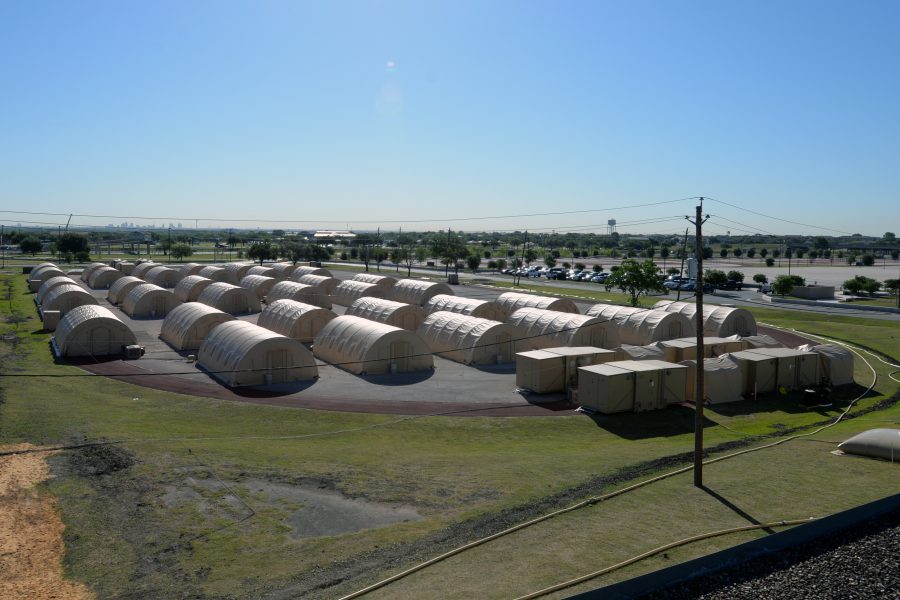A tent city erected at Joint Base San Antonio-Lackland, Texas, on April 28 not only gave Air Education and Training Command “swing space” to ensure its Basic Military Training recruits and tech school students heeded COVID-19-era social distancing mandates, but it also gave the command a chance to make much-needed dorm repairs, AETC boss Lt. Gen. Marshall B. “Brad” Webb said Sept. 16.
The system, which is slated to deactivate on Oct. 1, is on loan from Air Force Materiel Command and staffed by Airmen from the base’s 433rd Airlift Wing and the Texas Air National Guard’s 149th Fighter Wing.
“That tent city gave us a lot of flexibility,” Webb said during a panel on USAF talent management that was held as part of the AFA’s virtual Air, Space & Cyber Conference. “It also gave us the opportunity to … take down dorms kind of one at a time and get some phased maintenance, if you will, accomplished on those, and it’s gotten us on a really, really strong footing.”
Brig. Gen. Caroline M. Miller, commander of Joint Base San Antonio and the 502nd Air Base Wing, said these improvements were a joint effort between the 502nd ABW and the 37th Training Wing.
“The 502[n]d Air Base Wing secured a BEAR, or Basic Expeditionary Airfield Resource, base kit that delivered a capability to the installation to continue training Airmen in the event of a catastrophic infrastructure failure to one of AETC’s weapon system platforms (i.e., training dormitories),” she said in a Sept. 18 statement to Air Force Magazine. “Recognizing the critical vulnerability and capitalizing on the opportunity Tent City provided, we coordinated a plan with the 37th Training Wing, providing engineers from the 502[n]d Civil Engineer Squadron with a safe, controlled environment with minimal impact to the training mission.”
Since May 1, these engineers have performed “critical maintenance” on 11 buildings at Lackland, including “recruit, housing and training, Airmen training complexes, and dining/classroom facilities,” finished over 2,500 work orders, and resolved a maintenance backlog, she said.
“This is similar to the phased maintenance completed on aircraft to ensure their sustainment and operational readiness,” Miller added.
Lackland’s dorms demand the same kind of careful and consistent attention that USAF’s aircraft are given, said 37th Training Wing Commander Col. Rockie K. Wilson.
“AETC’s training dormitories are a unique asset that require proper sustainment to produce the Airmen we need,” he said in a Sept. 18 statement to Air Force Magazine. “Since these facilities are foundational to developing Airmen, they need to be sustained like a weapon system.”
While the combination of these buildings’ ages, the constant nature of AETC’s training mission, and the pandemic environment have made this crucial upkeep challenging, Wilson said the wing and its “joint base partners” have risen to the challenge.
“For the BMT specifically, much of this has to do with enabling access in conjunction with periods where our trainees are dislocated for readiness training and during non-accession periods to allow our Military Training Instructors to reconstitute themselves and their families,” he said. “The evolution of this process synergizes both the resilience of our training facilities with the readiness and resilience of our Airmen.”
In addition to these recent fixes, Wilson noted that two new dorms currently under construction at the base are slated to be finished by 2023. Two others should be tentatively constructed by 2026, he added.
“These projects will effectively mark the complete recapitalization of the legacy training facilities for basic military training,” he said.
In an April interview with Air Force Magazine, then-Air Force Chief of Staff Gen. David L. Goldfein cited AETC’s employment of the tent-city system as an example of the command’s creative approach to tackling the coronavirus challenge.

